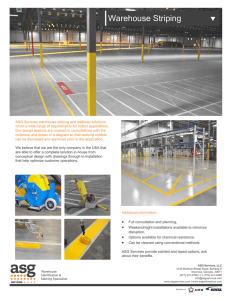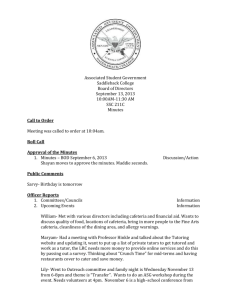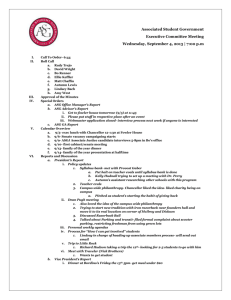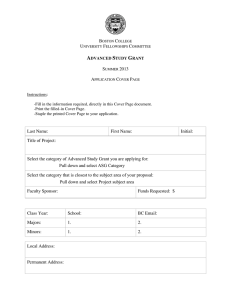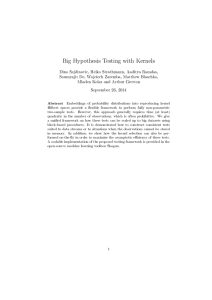Senior Management Leadership in the Irish Civil Service
advertisement
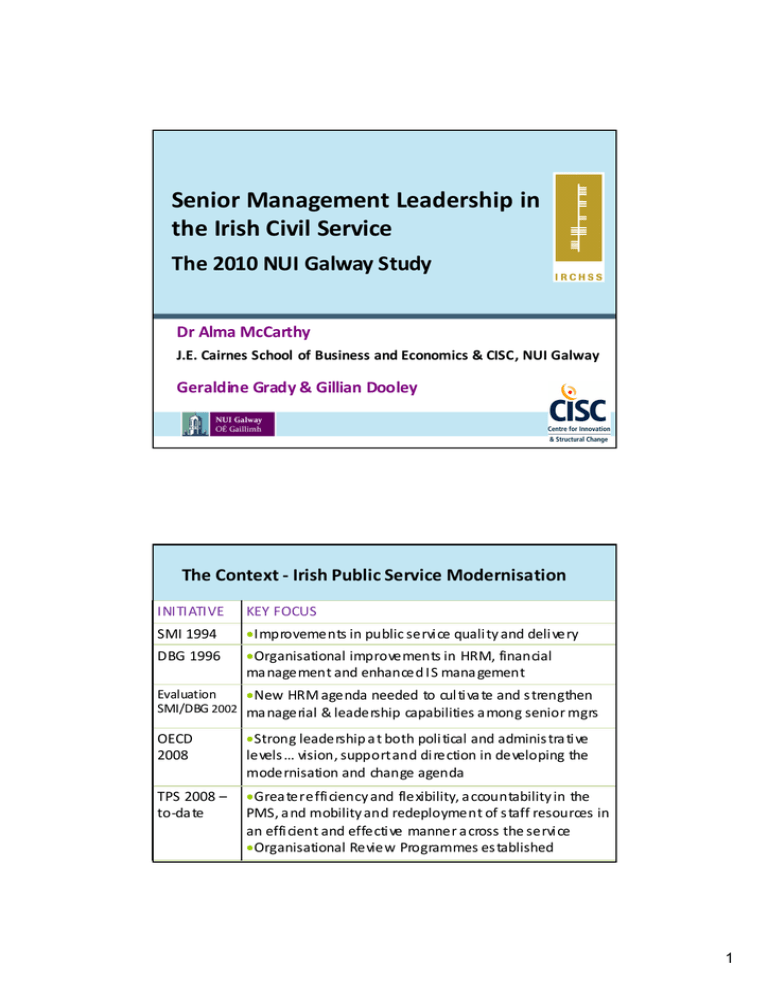
Senior Management Leadership in the Irish Civil Service The 2010 NUI Galway Study Dr Alma McCarthy J.E. Cairnes School of Business and Economics & CISC, NUI Galway Geraldine Grady & Gillian Dooley The Context - Irish Public Service Modernisation INITIATIVE KEY FOCUS SMI 1994 Improvements in public servi ce quali ty and deli very DBG 1996 Organisational improvements in HRM, financial ma nagement and enhanced IS mana gement Evaluation New HRM agenda needed to cul ti va te and s trengthen SMI/DBG 2002 ma nagerial & leadership capabilities a mong senior mgrs OECD 2008 Strong leadership a t both poli tical and adminis tra ti ve levels … vision, supportand di rection in developing the modernisation and change agenda TPS 2008 – to-da te Grea tereffi ciency and flexibility, a ccountability in the PMS, a nd mobility and redeployment of s taff resources in an effi cient and effecti ve manner a cross the servi ce Organisational Review Programmes es tablished 1 The Role of Leadership • New public management and public sector reform rely heavily on effective leadership (Hartley & Allison, 2000; Van Wart, 2003; McLoughlin & Wallis, 2007) • General acceptance of the criticality of leadership – “leaders make a difference to their subordinates’ satisfaction and performance and in whether their organisation succeeds or fails” (Bass, 1990: 22) • Limitation with many leadership theories is the limited focus on leadership traits and competencies but less on results and impact (Ulrich et al., 1999; 2008) The Leadership Code Ulrich, D., Smallwood N., Sweetman, K., 2008 TIME Human Capital Developer Long-Term Strategic Build next generation talent/succession planning Individual Focus of & their abilities Attention Shape the Future Personal Proficiency Invest in Self Talent Manager Engage Existing Talent Strategist Organisation & its capabilities Executor Near-Term Strategic Make Things Happen 2 Domains & Competencies Human Capital Developer Map workforce Staff career development Next gene ration ta lent development Networking Talent Ma nager Communication Create aligned direction Staff compete ncy development Resource management Work environment Personal Proficiency Clear thinking Self-knowledge Tolerate Stress & Resilience Learning agility Character & integrity Achieve personal results Strategist Vision Custome r centric strategy Create s trategic traction Executor Make change happen Accounta bility Teambuilding Ensuring technical proficiency Data Gathering in the Irish Civil Service (a) • Customisation and review of online instrument • 13 Departments + Office of the Revenue Commissioners participated – Research Team and SG meetings in all Departments – 6-16 SG, ASG, PO in each org (depending on size of organisation and no. senior managers) • April – August 2010 • 146 senior managers in total: 8 SG; 37 ASG; 101 PO 3 Data Gathering in the Irish Civil Service (b) • 360-degree review process using online instrument • 1200 completed questionnaires: – 146 ma nagers/sel f assessments – 134 ma nager assessments – 403 peer assessments – 517 di rect report assessments Rating Scale • Respondents were asked to assess the focal individual’s competence level for each question using a five-point scale as follows: 1 = Poor 2 = Fair 3 = Good 4 = Very Good 5 = Outstanding 4 The Online 360 Questionnaire • 9 demographic and human capital questions • 72 questions assessing 27 leadership competencies across 5 domains – quantitative using 5 point scale • 3 open-ended qualitative questions for raters: – Senior mana ger’s top 3leadership s trengths – Senior mana ger’s top 3leadership development needs – Public sector/Ci vil Servi ce context factors a ffecti ng leadership capability Departments & No. of Participating Managers 5 Demographics (a) Gender: male (71% male, 29% female) Age: the majority (79%) were between 50 and 60 years Demographics (b) PS Tenure: 80% working for 20 or more years in the public service Job Tender: 4 to 10 years in a senior management position 6 Current Leadership Capability Top 5 Strengths (overall) TOP STRENGTHS SCORE DOMAIN 1) Demons tra te Lea rning Agility 4.17 Personal Profi ciency 2) Balance Work and Non-Work demands (including delega tion) 4.00 Personal Profi ciency 3) Tolerate Stress & Resilience 3.86 Personal Profi ciency 4) Self Knowledge 3.86 Personal Profi ciency 5) Deli ver Resul ts 3.85 Personal Profi ciency 7 Top 5 Development Needs TOP DEVELOPMENT NEEDS SCORE DOMAIN 1) Ma p the Workforce 3.26 Human Ca pital Developer 2) Align organisational & employee expectations 3.40 Human Ca pital Developer 3) Help People Mana ge Thei r Ca reers 3.51 Human Ca pital Developer 4) Communi cation 3.55 Talent Ma nager 5)Pra cti ce Clear Thinking 3.57 Personal Profi ciency Congruence in Leadership Scores Across Rating Sources 8 Leading in the Public/Civil Service Context (a) • Content analysis methodology to analyse and thematically organise the 618 qualitative comments regarding factors affecting leadership in CS • These included – peer to peer comments about constraints at same gra de – comments by di rect reports – comments by mana gers • 7 key emerging themes Leading in the Public/Civil Service Context: 1. Leadership & Risk Leadership & Risk: balance between risk-taking, maintaining the status quo and facilitating innovation and creativity • “it is important to safeguard the integrity of public sector organisations by ensuring suitable processes, but the public service process may sometimes get more emphasis in terms of risk mitigation than outcomes” APO • “the public service tends to have more emphasis on risk mitigation than outcomes and thus a lack of scope for innovative thinking prevails” APO 9 Leading in the Public/Civil Service Context: 1. Leadership & Risk • “public sector organisations operate in a highly risk averse environment, dictated by demands of public accountability and the media focus. This permeates organisational culture and impedes capacity to offer freedoms and latitude to individuals to pursue new approaches and adopt responsive service innovations”. ASG Leading in the Public/Civil Service Context: 2. Rigidity of Organisation, Structure & Process Rigidity and inflexibility: s tructure of the public sector and i ts bureaucra ti c form is seen as a signifi cant sector specifi c fa ctor adversel yi mpa cting leadership effecti veness • “the structures and restrictions of government, as distinct from the private sector, often times limits options, time taken to change and require outmoded channels to be maintained and result in the inability to readily invest 'profits' (aka savings/extra exchequer returns) in new or experimental ventures”. ASG 10 Leading in the Public/Civil Service Context: 2. Rigidity of organisation, Structure & Process • “the rigid Industrial Relations structure hinders flexibility” PO • “inability to use carrot and stick effectively “ PO • “The tools available to managers to motivate staff are limited. There are very limited sanctions available, and capacity to reward is severely constrained too” ASG Leading in the Public/Civil Service Context: 3. Political System Influence Political Influence: constraining to leadership effectiveness and achievement of results • “the interaction with the political system is of relevance and is a factor which does of course influence effective leadership in the public sector” PO • “political environment in which the public servant operates can dilute the impact of leadership e.g. initiatives which might have been led strongly could be removed from the political agenda with a change of Government or Minister” AS 11 Leading in the Public/Civil Service Context: 3. Political System Influence • “our public service needs to become more business-like and to deliver public goals more quickly. The highest levels of our public service need to rediscover the capacity to influence government policy through their ministers. It is not enough merely to 'give the minister what he wants'. Who fashions and pursues long-term national goals? No one!” AS Leading in the Public/Civil Service Context: 4. Culture Public sector culture affects leadership and need for new leadership culture driven by top management • “unless the public service employee has support from the top, it is hard for the next level of management to change the attitude of a public sector organisation. This applies both in its attitude to its external stakeholders and its internal staff” ASG • “effective leaders in the public sector in the future will be the ones who operate from a platform of openness, accountability, empowerment and ‘considered self-interest’ and work solely from a position of ‘leading by example’” PO 12 Leading in the Public/Civil Service Context: 5. Recruitment, Selection & Promotion Constraints R, S & P constraints: restrict managers to effectively select, manage and develop staff • “there needs to be more delegation of human resource practices, responsibilities and recruitment of staff from the Centralised Personnel Unit to the Regional Management Team” ASG • “a more appropriate system of selection and promoting personnel needs to be developed. This could involve psychological assessments of a person’s values, attitudes, commitment, beliefs, thinking patterns etc. This allied with assessing academic qualifications, achievements, experience etc. would be more likely to identify the Leaders of Tomorrow that are required ” PO Leading in the Public/Civil Service Context: 5. Recruitment, Selection & Promotion Constraints • “many public sector employees have experience/qualifications that are either not utilised or are under utilised. Leaders need to be able to identify these people and place them in positions where their talents may be used for the benefit of the organisation” APO • “within the Civil Service, one is allocated resources and there is often little scope to have all the staff/skills required assigned to a Division as the better people are generally recognised within the organisation and are highly sought and competed for” ASG 13 Leading in the Public/Civil Service Context: 6. Resource to Cope with Demands Much reference to challenge of cutbacks, employment control framework and resource constraints • “Currently leaders in the Civil Service in particular are having to do more and more with fewer people and less money. This will stretch people's time and energy” PO • “The sudden decapitation of leadership through the incentivised retirement scheme and threats to our pensions has led to increased workload for all and many staff having to learn new areas of work without the hitherto reasonably smooth transfer of work and corporate knowledge” APO • “Moratorium on recruitment and promotions is affecting development of future leaders as talented people will leave and necessary new blood is not entering the public sector” APO Leading in the Public/Civil Service Context: 7. Lack of Systems that Enforce Accountability Perceived lack of systems to enforce accountability in public and civil service context – esp staff performance • “civil service culture whereby the requirement to deliver by managers is not paramount/obligatory. Real accountability is still not in evidence in most Government Departments” PO • “there is curren tly a lack of effective processes to allow managers apply appropriate sanctions where staff fail to meet performance targets” PO 14 Conclusions & Recommendations (a) • Change in the civil service largely rests with incumbent senior managers – thus leadership capability critical • Highest rated leadership dimension is personal proficiency (stress management, learning agility, integrity, energy, commitment) • Lowest rated domain is human capital developer (long term staffing perspective) – EO to PO appointment process – inflexibility in terms of matching competence to re quirements as panel based • Notwithstanding the existence of certain public & civil service sector context factors and constraints, our study finds that there is a clear acknowledgement and understanding of the need for change among senior civil service leaders Conclusions & Recommendations (b) • Need for a more effective performance management system – “ca rrotand s ti ck” to moti va te, maintain and address employee performance – the authori ty and adequate control mechanisms to effect real change – percei ved to be absent a t present • Sense that risk taking, creativity and innovation are stifled and discouraged among the study respondents – Conserva ti ve and risk a verse – Need more innova tion a nd crea ti vity 15 Conclusions & Recommendations (c) • Human capital development – Among mid management levels – building ne xt gene ration tale nt – Move from short-te rm HR iss ues to longe r-te rm planning – Greate r focus on specialist skills ra ther than generalis t • Senior management leadership development – Leadership effectiveness can be developed and enhance d – Education, experience, mentoring, coaching, job assignme nts etc. • “Better systems for identifying and nurturing talent focusing on the top management cadre are required. More structured career planning and mobility through a Senior Public Service is essential in making progress here generally”. Assistant Secretary General 16
